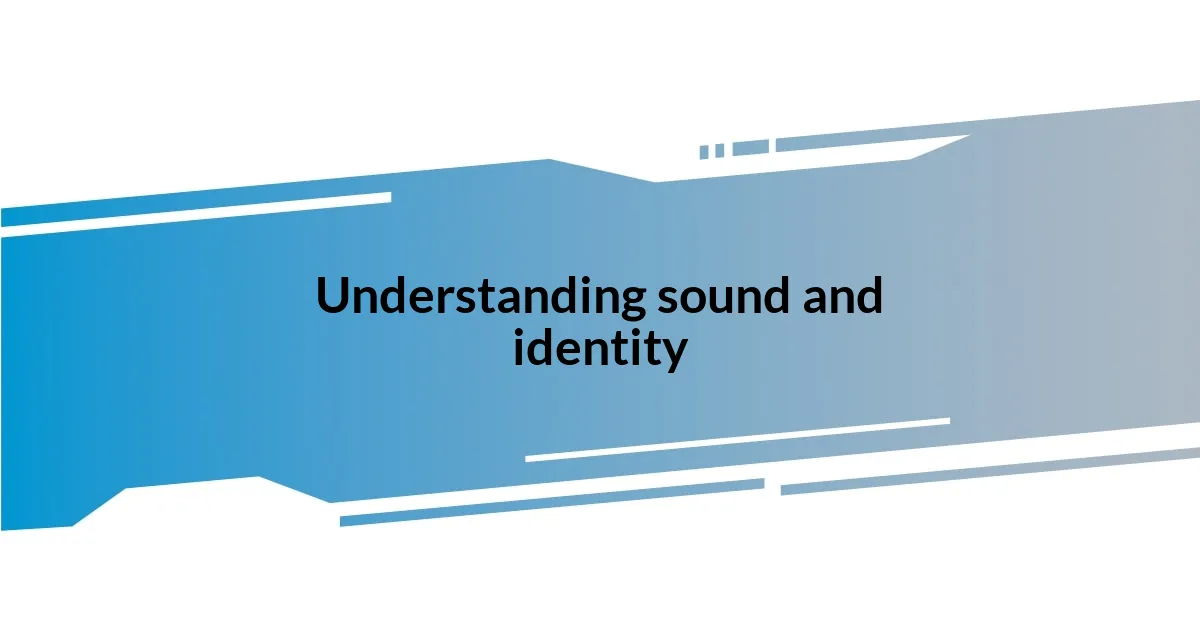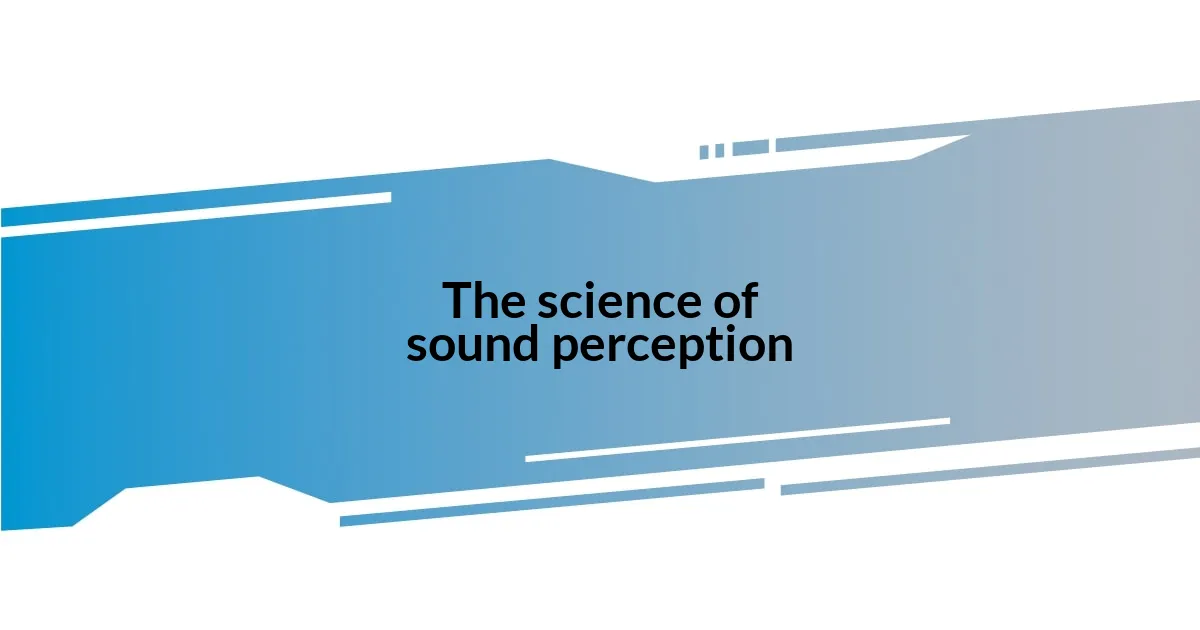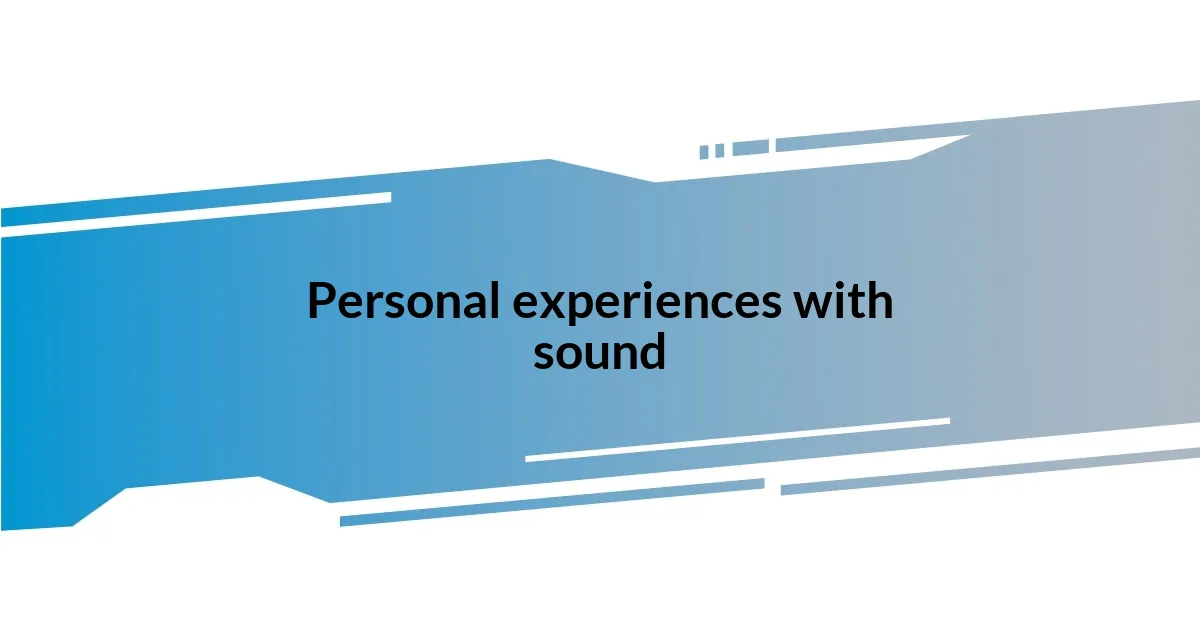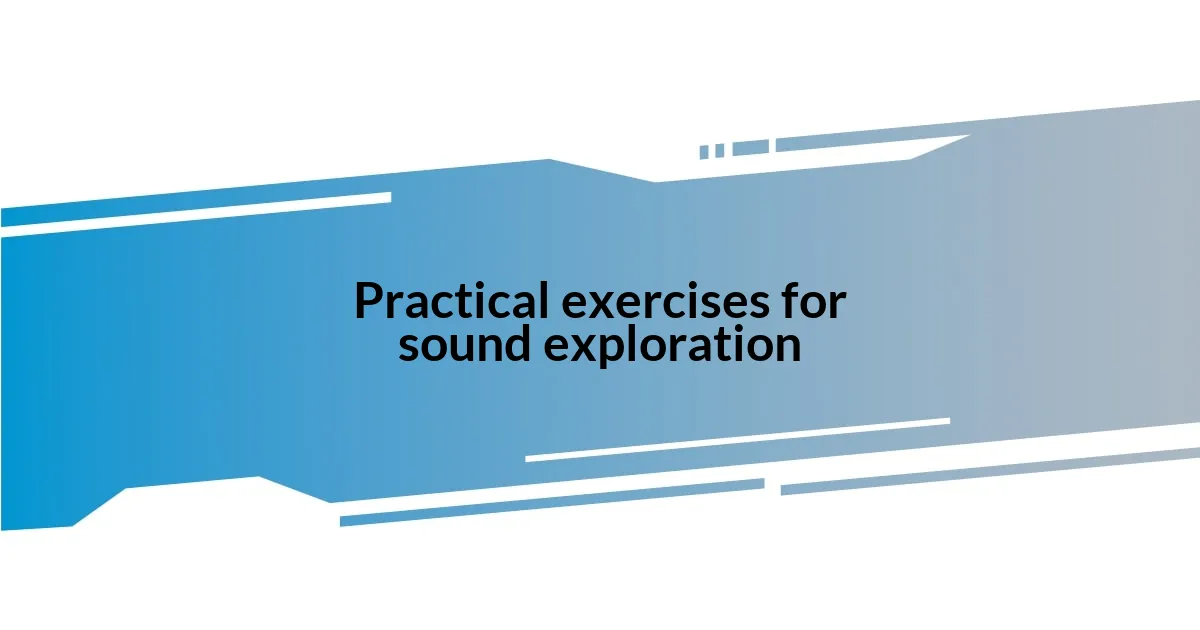Key takeaways:
- Sound significantly shapes our identities, evoking memories and emotions tied to personal and cultural experiences.
- The complex interaction of sound perception involves biology and psychology, influencing how individuals relate to auditory stimuli based on personal history and culture.
- Music serves as a powerful medium for self-expression, reflecting personal growth and cultural narratives, while also fostering connections among people.
- Practical exercises like creating sound diaries and experimenting with sound layering can deepen personal exploration and understanding of identity through sound.

Understanding sound and identity
Sound is a powerful force that often transcends words, shaping our identities in profound ways. I remember a moment from my childhood when a familiar song brought back a flood of memories; it felt like a sonic time machine, reawakening the essence of who I was at that age. Can you recall a sound that instantly transports you to a different chapter of your life?
As I delved into the world of sound, I began to notice how different music styles resonate with various aspects of my identity. For example, jazz reflects my more spontaneous and creative side, while classical music grounds me in moments of reflection and calmness. Isn’t it fascinating how the rhythm of a piece can mirror the rhythm of our lives?
Moreover, our cultural backgrounds also play a significant role in shaping our auditory experiences. I’ve found that traditional sounds from my heritage evoke a deep sense of belonging and nostalgia. How do the sounds from your own culture connect with your identity? This inquiry into sound not only enhances our understanding of ourselves but also fosters a greater appreciation for the diverse tapestries of identity around us.

The science of sound perception
When we discuss sound perception, it’s fascinating to explore how our brains interpret different frequencies and amplitudes. For instance, I’ll never forget the time I stood by the ocean, listening to the rhythmic crashing of waves. In that moment, it wasn’t just sound; it became a meditative experience that calmed my racing thoughts. This interaction between sound, our emotional state, and brain function is a testament to the complexity of auditory perception.
I also find it intriguing how sound can evoke specific memories or emotions, often without us even realizing why. During a nostalgic road trip, every tune from my favorite playlist felt like a chapter from a cherished book, sparking emotions tied to various life events. It’s as if each sound has its own story intertwined with our personal narrative, shaping our identity in ways we often overlook.
Moreover, the science behind sound perception reveals the fascinating interplay of biology and psychology. Our ears pick up sound waves, translating them into signals that the brain processes. But the story doesn’t end there; our individual experiences, culture, and even personal sensitivities all influence how we eventually perceive and react to those sounds. Have you ever considered how your unique experiences alter your auditory world? Reflecting on this can deepen your connection to both sound and self.
| Sound Property | Perception Impact |
|---|---|
| Frequency | Determines pitch; higher frequencies can evoke excitement. |
| Amplitude | Affects perceived loudness; louder sounds can trigger stronger emotional responses. |
| Duration | Influences how we perceive rhythm and movement in music. |
| Timber | Shapes the character of sound; certain textures can feel more familiar and comforting. |

Sound’s role in culture
Sound weaves itself into the fabric of culture in ways that are both profound and moving. I vividly remember the first time I heard traditional folk music at a family gathering. The melodies intertwined with laughter and stories, creating a vibrant tapestry of connection. It wasn’t just about the tunes; it was about belonging to a community that celebrated our shared identity. Every note seemed to echo not just the past, but also the values and traditions that shaped who we are.
Here are some ways sound plays a significant role in culture:
- Communication: Sounds like language, dialects, and accents convey cultural identity and heritage.
- Ceremony and Ritual: Sounds embedded in cultural practices, from drumbeats in ceremonies to chants in religious observances, mark important moments in life.
- Music Preservation: Traditional music serves as a vehicle for passing down history and storytelling within communities.
- Mood Setting: Different sounds evoke various emotions, helping to create a cultural atmosphere whether in celebrations or solemn events.
When I think about sound’s impact, I can recall times when I’ve felt a deep connection with my culture through the rhythm of a drum or the harmony of voices singing together. It brings a sense of unity and reminds me that I’m part of something larger than myself.

Personal experiences with sound
There’s something incredibly powerful about the sound of rain tapping against my window. I remember on one particularly stormy evening, I sat wrapped in a cozy blanket, listening intently as the steady rhythm created a soothing backdrop to my thoughts. In that moment, the world outside faded away. It became a sanctuary where I could reflect and connect with my inner self. Have you ever felt that specific sound completely transform your mood?
Another memorable experience was attending a live concert for a band I loved in college. As the first note struck, it felt like the energy in the room surged through me. I found myself dancing, laughing, and singing, completely united with everyone around me. The music wasn’t just a collection of sounds; it became a collective identity, merging our individual stories into one vibrant experience. It’s fascinating how shared sounds can foster connections among strangers, isn’t it?
One evening, I discovered the healing effects of sound during a peaceful meditation session that incorporated singing bowls. As the deep, resonant tones filled the room, I could feel the vibrations resonating within me, melting away stress and anxiety. This experience taught me that sound can be a powerful tool for self-discovery and emotional healing, guiding us to deeper understanding of ourselves. What sounds have you found to be healing in your life?

Identity formation through music
Music is an incredible force in shaping our identities. I still remember the first time I connected with reggae music through a friend. The vibrant rhythms and heartfelt lyrics spoke to me in ways I hadn’t experienced before. It wasn’t just about enjoying the beats; it was about embracing a cultural movement that emphasized love, unity, and resistance. Have you ever felt an artist or genre resonate with your own life experiences, almost as if they were telling your story?
As I delved deeper into my love for music, I found that it influenced not just my tastes but also how I viewed myself. I recall creating a playlist for a significant milestone in my life, each song capturing a moment, a feeling, or a struggle I had faced. That playlist became a snapshot of who I was at that time, a musical autobiography of sorts. Isn’t it striking how our favorite songs can act as a mirror, reflecting our evolution and personal growth?
Moreover, playing an instrument became a transformative outlet for my identity. When I picked up the guitar, I didn’t just learn chords; I found a voice that was uniquely mine. Each strum allowed me to express emotions I hadn’t articulated before—joy, sadness, even anger. This journey of musical expression taught me that sound is not only a form of art but a profound way to assert who we are in a complex world. Can you relate to discovering parts of yourself through the melodies and rhythms that resonate deeply within you?

Case studies on sound identity
In exploring sound identity, one fascinating case study involves a community choir that brings together individuals from diverse backgrounds. In my experience, singing together creates a unique blend of voices that forms a new identity, one that embodies collective experiences and emotions. Have you ever felt a sense of belonging in a group setting, amplified by the harmony of shared sound? This choir became a beautiful representation of how sound can bridge cultural divides and foster unity.
Another compelling example is the impact of sound in indigenous communities, where traditional music often plays a critical role in identity formation. I remember attending a cultural festival where the rhythmic beating of drums intertwined with storytelling. It wasn’t just entertainment; it was a ritual that connected the audience to their history and ancestry. Isn’t it incredible how these sounds are imbued with meaning, serving as a conduit for transmitting values and narratives through generations?
In a different vein, consider the fascinating world of soundscapes in urban environments. I came across a project where researchers recorded city sounds, allowing residents to rediscover their spaces. These recordings revealed how familiar noises like laughter in a park or traffic honks became part of their identities. I found myself pondering—how often do we take our ambient sounds for granted? Each sound reflects a piece of the urban puzzle, showcasing how our environments shape our collective and individual identities.

Practical exercises for sound exploration
When it comes to practical exercises for sound exploration, one simple yet powerful approach is to create a personal sound diary. I’ve done this myself, dedicating a few moments each day to recording sounds that capture my attention—birds singing, distant traffic, even the hum of my refrigerator. It might sound mundane, but I’ve discovered that revisiting these recordings brings a flood of memories and emotions. What ordinary sounds in your daily life resonate with you?
Another exercise is to experiment with layering sounds. I remember a project where I fused different ambient tracks with my own voice reading snippets of my favorite poetry. The result was mesmerizing and deeply personal, allowing me to convey emotions that were often hard to express. Have you ever tried blending your own sounds with those around you? It opens a whole new world of creative expression.
Lastly, I recommend exploring sound through movement. I once joined a dance workshop that encouraged participants to improvise based on the sounds playing in the background. As I moved my body in response to the rhythm, I felt an awakening of my identity that I hadn’t fully tapped into before. How does your body react to different sounds? This exercise not only connects you with your physical self but also allows you to discover how sound can influence your emotions and identity in real-time.